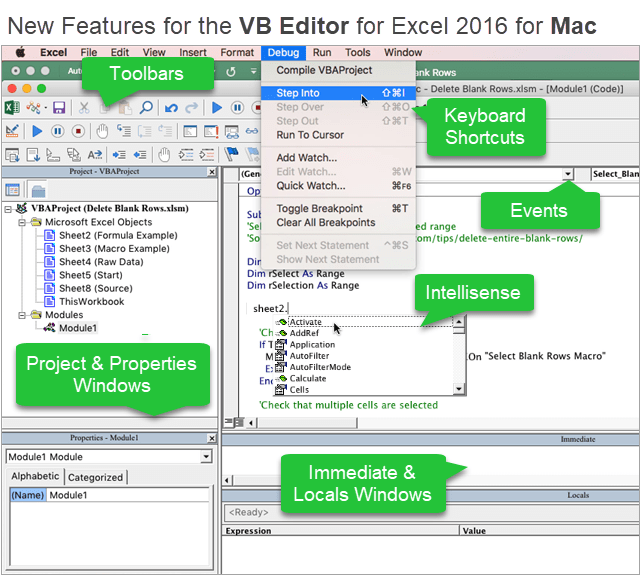The 26-year-old Visual Basic programming language just won't go away, as Microsoft just announced plans to bring its IDE back to the Office for Mac environment. 'Many of you have noticed the limited Visual Basic development environment that shipped with Office 2016 for Mac, and have asked for the.
I was working on a task in Word's VB Editor — that's Word 2016 for Mac — that needed associative arrays, and quickly found references to 'Scripting.Dictionary', and then figured out that it comes from a library that is not installed with Office 2016 for Mac.
I found this question pointing to a third party library after a lengthy search. 2+ hours more searching, and I still can't figure out how to load it into Word. I found this reference to sandboxing, but it's talking about .dylib files and I've got a .cls — seems like a mismatch. There are oodles of references to loading libraries in Excel, but nothing I've found regarding Word has worked.
So, if I have a .cls file containing the source code for a library such as the one I've linked, how do I bring it into Word?
Javascript Editor For Mac
1 Answer
- Open the VB editor in Word
- Right-click on the VBProject you're working on (or select it and choose Import file from the VB editor File menu)
- Select Import File...
- Browse to the cls file, select it and click the Open button
Vb Editor For Mac
Mac Text Editor
Not the answer you're looking for? Browse other questions tagged vbamacosms-word or ask your own question.
You can set the properties for a Visual Basic project, and then set how you want to help protect the project.
Do either of the following:

Set the project properties
To begin, click Tools > Macro > Visual Basic Editor.
On the Tools menu, click VBAProject Properties (In Word, click Project Properties), and then click the General tab.
In the Project Name box, enter the name that identifies your component in the registry of the Object Browser.
The project name is the name of the type library for your component. The type library, or TypeLib, contains the description of the objects and interfaces provided by your component.
In the Project Description box, enter the description that will display in the Description pane at the bottom of the Object Browser.
In the Conditional Compilation Arguments box, enter the constant declarations used for conditional compilation.
Help protect the project
You can lock a project to help prevent someone from changing it or set a password to view the project properties.
On the Tools menu, click VBAProject Properties, and then click the General tab (In Word, click Project Properties, and then click the Protection tab).
To lock your Visual Basic project, select the Lock Project for Viewing check box.
Under Password to View Project Properties, in the Password box, enter the password and then in the Confirm Password box, enter the password again.